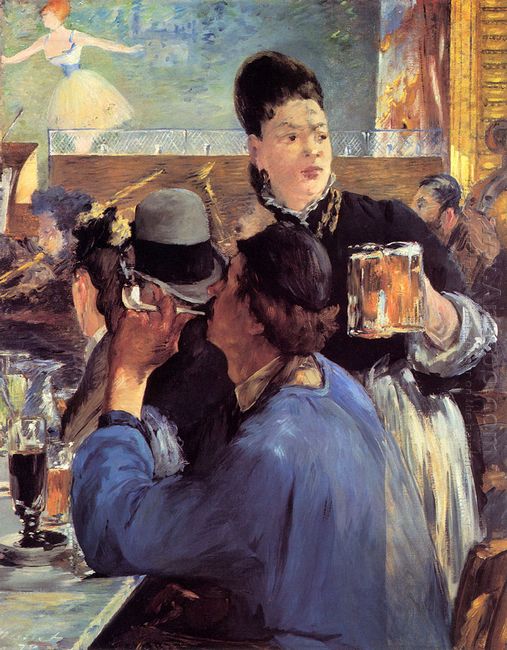Under the influences of the Impressionist friends, Edouard Manet abandoned the style with dark colors and traditional themes after 1870 and accepted the light-colored series and also dedicated to the subjects of contemporary life. Among these themes, cafes occupied an important position. All the 19th century was the prosperity of the Paris cafes. These were all kinds of cafes, the coffee halls such as hotels and beer bars provided the customers with songs and dances. The painters worked all day long in the studio would go for a drink, smoking, talking about arts or listening to the popular songs the pop singers song. They would meet some models there sometimes. In fact, the cafes were the places where people mingled, people of all social classes appeared there, it was acceptable that there were even some single women(the synonym of prostitutes women) patronized there.

As well as the contemporaries, Manet went to the café house nearby frequently, whether it was dressy or ordinary. These places sometimes could give here creative inspirations. He was the regular of the coffee dance hall which located at the foot of the Montmartre hill. He often made some live sketches which showed the customers in the café and the scenes of shows. And then, he depicted these scenes as a significant draw in the studio, if he was not satisfied with the painting, he would split in into two pieces and then painted again on another canvas of the same theme. That was the painting in the Orsay museum.
The painting suffered the same fate as well, the trilateral sides had been cut and only the right side was remained. In order to show the overcrowded, smoggy and noisy scene of the café dance hall, he painted the objects as close as possible. They were five mainly types of people who represented all the social classes merging frequently in the place: a waitress, a worker with blue jacket, a bourgeois who was seen wearing a top hat and a woman and a female singer. Their faces were all been cut partially deliberately with the purpose of giving people a impression that this was a glimpse of nature or fast micrograph of arbitrary truncation space.
The female singer had only half body, it still felt weird even the other impressionists especially Degas also used this technique. Except the waitress was watching on the audience, the eyes of the others’ turned to the translucent silhouette of the singer appeared on the stage. He arranged the screen space through the eyes of the people in the painting to make opposite contacts between the foreground and background. All the figures seemed flatten in the painting, only the face of the waitress, beer cups, pipes, black hat, and the branches pendent lamp were visible clearly in the hazy painting. In order to show the lively atmosphere of the coffee dance hall, to shine the light, Manet picked up another vigorous and effective brush of the Impressionist, coloring with parallel and cross strokes which would not leave edges of sketching contours.
This painting was a special witness claimed that Manet was interested the paintings representing the scenes of life. Degas and Renoir mainly depicted such scenes.